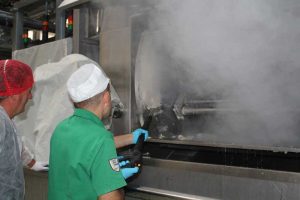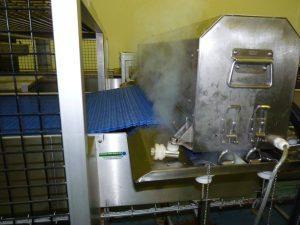Conveyor belt cleaning is a vital aspect of maintaining a safe and efficient industrial facility. Clean conveyor belts are essential for preventing contamination of products, ensuring worker safety and maintaining the overall efficiency of the production process. Contaminated conveyor belts can lead to product spoilage, which may result in financial losses for the company.
Moreover, dirty conveyor belts can pose a safety hazard for workers, as they can become slippery and cause accidents. Furthermore, the accumulation of debris and residue on conveyor belts can lead to equipment malfunctions and breakdowns, resulting in costly repairs and downtime. Therefore, regular and effective conveyor belt cleaning is essential for the smooth operation of industrial facilities.
In addition to preventing product contamination and ensuring worker safety, clean conveyor belts also contribute to the overall efficiency of the production process. When conveyor belts are free from debris and residue, they can operate at their optimal capacity, ensuring a smooth flow of materials throughout the facility. This not only improves productivity but also reduces the risk of bottlenecks and delays in the production process.
Furthermore, clean conveyor belts are less likely to cause damage to products, reducing waste and improving the overall quality of the end products. Therefore, investing in effective conveyor belt cleaning is essential for maintaining a high level of efficiency in industrial facilities.
Summary
- Proper conveyor belt cleaning is crucial for maintaining a safe and efficient industrial facility
- Dry steam offers advantages such as reduced water usage and faster drying times for conveyor belt cleaning
- Efficient dry steam conveyor belt cleaning involves using high temperature and low moisture steam to dislodge and remove dirt and debris
- Dry steam conveyor belt cleaning is environmentally friendly, as it reduces water consumption and eliminates the need for harsh chemicals
- Choosing the right equipment for dry steam conveyor belt cleaning is essential for achieving optimal results and efficiency
The Advantages of Using Dry Steam for Conveyor Belt Cleaning
Cleaning and Sanitising without Harsh Chemicals
One of the main advantages of using dry steam for conveyor belt cleaning is its ability to clean and sanitise without the use of harsh chemicals. Dry steam is capable of reaching high temperatures, which allows it to effectively kill bacteria, viruses, and other pathogens on conveyor belts. This not only ensures that the belts are clean but also helps to maintain a hygienic environment in the facility.
Reaching Tight Spaces and Crevices
Additionally, using dry steam eliminates the need for chemical cleaners, reducing the risk of chemical residue contaminating products and the environment. Another advantage of dry steam cleaning is its ability to reach tight spaces and crevices on conveyor belts. The high temperature and pressure of dry steam allow it to penetrate into hard-to-reach areas, effectively removing dirt and debris that may be missed by traditional cleaning methods.
Reducing Water Consumption and Waste
Finally, dry steam cleaning reduces water consumption and waste compared to traditional cleaning methods. Traditional methods often require large amounts of water for cleaning, which can lead to excessive water consumption and waste. Dry steam cleaning, on the other hand, uses minimal water, as the steam quickly evaporates after cleaning. This not only reduces water consumption but also minimises the generation of wastewater, making it an environmentally friendly cleaning option.
The Process of Efficient Dry Steam Conveyor Belt Cleaning

Efficient dry steam conveyor belt cleaning involves several key steps to ensure thorough and effective cleaning. The process begins with a thorough inspection of the conveyor belt system to identify areas that require cleaning and any potential issues that need to be addressed. Once the inspection is complete, the next step is to prepare the dry steam cleaning equipment and ensure that it is properly calibrated for the specific requirements of the conveyor belt system.
After the equipment is prepared, the dry steam cleaning process begins with pre-treatment to loosen and soften any stubborn dirt or debris on the conveyor belt surface. This may involve applying steam at a lower pressure to gently break down contaminants before increasing the pressure for more thorough cleaning. Once the pre-treatment is complete, the main cleaning phase begins, during which high-pressure dry steam is applied to the entire surface of the conveyor belt to remove dirt, grease, and other contaminants.
Following the main cleaning phase, a thorough inspection is conducted to ensure that all areas of the conveyor belt have been effectively cleaned. Any remaining stubborn stains or residues are targeted with additional dry steam treatment until the entire surface is clean and sanitised. Finally, after the cleaning process is complete, it is essential to conduct a post-cleaning inspection to verify that all contaminants have been removed and that the conveyor belt system is ready for operation.
The Environmental Benefits of Dry Steam Conveyor Belt Cleaning
| Environmental Benefits | Metrics |
|---|---|
| Water Conservation | Reduction in water usage by up to 95% |
| Chemical-Free Cleaning | Elimination of chemical usage |
| Energy Efficiency | Lower energy consumption compared to traditional cleaning methods |
| Waste Reduction | Less waste generated from cleaning process |
Dry steam conveyor belt cleaning offers several environmental benefits compared to traditional cleaning methods. One of the main environmental benefits is its ability to reduce water consumption and waste. Traditional cleaning methods often require large amounts of water for cleaning, which can lead to excessive water consumption and the generation of wastewater.
Dry steam cleaning, on the other hand, uses minimal water, as the steam quickly evaporates after cleaning. This not only reduces water consumption but also minimises the generation of wastewater, making it an environmentally friendly cleaning option. Furthermore, dry steam cleaning eliminates the need for harsh chemical cleaners, reducing the risk of chemical contamination in the environment.
Chemical cleaners used in traditional cleaning methods can pose a threat to water sources and ecosystems if they are not properly disposed of or if they leach into the environment during use. By using dry steam for conveyor belt cleaning, companies can avoid these environmental risks and contribute to a cleaner and safer environment for all. Additionally, dry steam cleaning reduces energy consumption compared to traditional cleaning methods that may require heating large volumes of water for cleaning.
Dry steam is produced using minimal water and electricity, making it a more energy-efficient option for conveyor belt cleaning. This not only reduces operational costs but also minimises the environmental impact associated with energy consumption.
Choosing the Right Equipment for Dry Steam Conveyor Belt Cleaning
When choosing equipment for dry steam conveyor belt cleaning, it is essential to consider several key factors to ensure that the selected equipment meets the specific requirements of the facility. One of the most important factors to consider is the capacity and power of the dry steam generator. The capacity of the generator should be sufficient to provide a continuous supply of dry steam at the required pressure and temperature for effective conveyor belt cleaning.
Additionally, it is important to consider the power source for the generator, whether it is electric or fuel-powered, based on the availability and cost-effectiveness of energy sources in the facility. Another crucial factor to consider when choosing equipment for dry steam conveyor belt cleaning is the flexibility and manoeuvrability of the steam delivery system. The equipment should be designed to reach all areas of the conveyor belt system without requiring disassembly or extensive manual labour.
This may involve selecting equipment with adjustable nozzles or attachments that can effectively target hard-to-reach areas and crevices on the conveyor belts. Furthermore, it is important to consider the safety features and certifications of the equipment to ensure that it meets industry standards for safe operation in industrial facilities. This may include features such as pressure relief valves, temperature controls, and safety interlocks to prevent accidents and ensure worker safety during operation.
Best Practices for Maintaining Clean Conveyor Belts in Industrial Facilities

Regular Inspections: The First Line of Defence
One of the best practices for maintaining clean conveyor belts is to conduct regular inspections to identify any signs of wear, damage, or contamination on the belts. This may involve visual inspections as well as using tools such as UV lights or swab tests to detect hidden contaminants on the belt surfaces.
Establishing a Regular Cleaning Schedule
Another best practice is to establish a regular cleaning schedule based on the specific requirements of the facility and production processes. This may involve daily, weekly, or monthly cleaning routines depending on factors such as product types, production volumes, and environmental conditions. It is essential to use effective cleaning methods such as dry steam cleaning to ensure thorough removal of dirt, grease, and other contaminants from conveyor belts.
Preventive Maintenance: A Proactive Approach
Furthermore, implementing preventive maintenance measures such as lubrication of moving parts, alignment checks, and tension adjustments can help prevent premature wear and damage to conveyor belts. Regular maintenance can also help identify potential issues before they escalate into costly repairs or downtime.
Case Studies: Successful Implementation of Dry Steam Conveyor Belt Cleaning in Industrial Facilities
Several industrial facilities have successfully implemented dry steam conveyor belt cleaning with positive results in terms of improved cleanliness, efficiency, and cost savings. One case study involves a food processing plant that switched from traditional water-based cleaning methods to dry steam cleaning for their conveyor belts. The facility reported significant reductions in water consumption and waste generation while achieving higher levels of cleanliness and sanitation on their conveyor belts.
Another case study involves a manufacturing facility that implemented dry steam conveyor belt cleaning as part of their sustainability initiatives. The facility reported reduced energy consumption and operational costs associated with conveyor belt cleaning while maintaining high standards of cleanliness and hygiene in their production processes. In both cases, successful implementation of dry steam conveyor belt cleaning resulted in improved operational efficiency, reduced environmental impact, and cost savings for the facilities.
These case studies demonstrate the effectiveness of dry steam cleaning as a sustainable and efficient solution for maintaining clean conveyor belts in industrial facilities.
If you are interested in learning more about the benefits of dry steam conveyor belt cleaning, you should check out the article on 5 Benefits of Installing a Conveyor Belt Cleaner for Maximum Efficiency. This article discusses how using a Conveyor Belt Cleaner can improve the efficiency of your operations and ensure a cleaner, safer working environment. It also highlights the cost-saving benefits of implementing a conveyor belt cleaning system.
FAQs
What is dry steam conveyor belt cleaning?
Dry steam conveyor belt cleaning is a method of cleaning conveyor belts using high-temperature, low-moisture steam. This process effectively removes dirt, grease, and other contaminants from the belt surface without the use of chemicals or excessive water.
How does dry steam conveyor belt cleaning work?
Dry steam conveyor belt cleaning works by using a specialized steam cleaning machine that produces steam at a high temperature and low moisture level. The steam is applied to the conveyor belt surface, where it loosens and lifts dirt, grease, and other contaminants. The steam also sanitizes the belt surface, killing bacteria and other pathogens.
What are the benefits of dry steam conveyor belt cleaning?
The benefits of dry steam conveyor belt cleaning include effective removal of dirt and contaminants, sanitization of the belt surface, reduced water usage, and elimination of chemical cleaning agents. This method is also environmentally friendly and can help to prolong the life of conveyor belts.
Is dry steam conveyor belt cleaning suitable for all types of conveyor belts?
Dry steam conveyor belt cleaning is suitable for most types of conveyor belts, including fabric, plastic, and metal belts. However, it is important to consult with a professional to ensure that the specific type of conveyor belt is compatible with dry steam cleaning.
Are there any safety considerations when using dry steam conveyor belt cleaning?
When using dry steam conveyor belt cleaning, it is important to follow safety guidelines and use appropriate personal protective equipment. The high temperature of the steam can cause burns, so operators should take precautions to avoid direct contact with the steam. Additionally, proper training and supervision are essential to ensure safe and effective use of the steam cleaning equipment.









